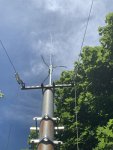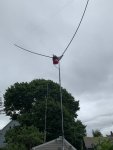azprospector
Member
I have a question for the group here. I’m considering putting up a Sigma Venom 5/8 Wave High Gain Silver Rod CB Base Station Antenna antenna at our place up north of us. Winds of 65 or more mph are not uncommon up there so an antenna like this one appears to be a good fit. The antenna would be mounted on a 2” X 25’ heavy steel tilt mast with 8 guy wires. This antenna has its own radials. These short radials seem extremely short in my opinion to be a really effective elevated ground plane. My question is this. Would it be beneficial to add 4 additional radials about a foot under the antenna itself? These radials wouldn’t be connected to the antenna itself in any way but would be mounted directly on the mast itself.



